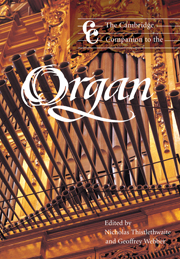6 - Organ building today
from Part I - The instrument
Published online by Cambridge University Press: 28 September 2011
Summary
Albert Schweitzer's status as a guru of twentieth-century organ building remains undiminished as the century draws to a close. The application of his intellect to an obscure musical craft remains a surprise to those who know him more as a philosopher, missionary and philanthropist. In fact the study of Bach and the organ was the major preoccupation of his early career and was a matter that he took as seriously as any other intellectual endeavour.
The work and worry that fell to my lot through the practical interest I took in organ-building made me wish that I had never troubled myself about it, but if I did not give it up the reason is that the struggle for the good organ is to me a part of the struggle for the truth.
(Schweitzer 1931)In this personal admission Schweitzer explains in the simplest possible terms why the organ, dependent on the technology and craft techniques of the middle ages and, at best, a complex and intractable means of making music, remains of enduring interest in a later age where entirely different technologies rule our daily lives (see Joy 1953: 186–213).
Twenty years ago – indeed perhaps at any time between 1930 and 1980 – it would have been obvious to explain Schweitzer's mission in terms of the classical revival: the Orgelbewegung or organ reform movement, built round the rediscovery of early instruments and the corresponding repertoire. In fact, though Schweitzer deplored the heaviness and (as he saw it) crudity of the average organ of c1900, he also had a message that links him to Ruskin and William Morris.
- Type
- Chapter
- Information
- The Cambridge Companion to the Organ , pp. 82 - 92Publisher: Cambridge University PressPrint publication year: 1999



